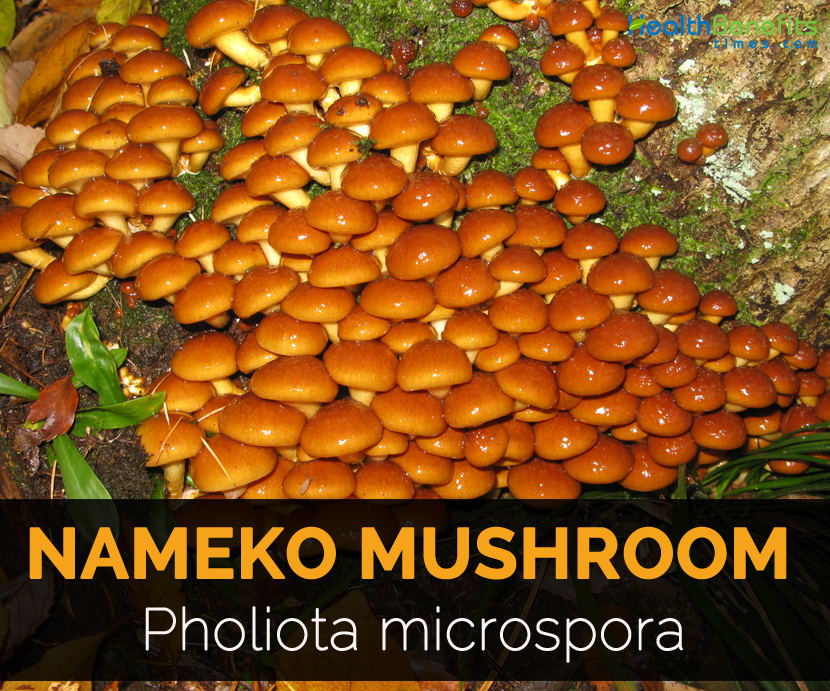| Nameko Mushroom Quick Facts | |
|---|---|
| Name: | Nameko Mushroom |
| Scientific Name: | Pholiota microspora |
| Colors | Amber-brown |
| Taste | Slightly nutty |
| Name | Nameko Mushroom |
|---|---|
| Scientific Name | Pholiota microspora |
| Common/English Name | Butterscotch Mushroom, Forest Nameko, Namerako |
| Name in Other Languages | Mandarin Chinese: Huá zi mó (滑子蘑), huá gū (滑菇); Russia: o-pyo-nok (опёнок), o-pya-ta (опята) |
| Pileus | 2-3.5 cm broad, light yellow to yellow brown |
| Flesh | White to slightly creamy |
| Stipe | 5-6 cm long, 0.5 cm broad |
| Basidia | 12-20×10-12 µm, clavate |
| Color | Amber-brown |
| Flavor | Mild, slightly earthy |
| Taste | Slightly nutty |
Health Benefits of Nameko Mushroom
- Combats cancer
Nameko mushrooms have good amounts of selenium which offers antioxidant, anticancer and anti-inflammatory properties and helps to reduce cancer, thyroid disease, heart disease and cognitive decline. The polysaccharides promote anti-tumor immunity and induce tumor cells apoptosis and exhibits anti-tumor properties.
- Prevent diabetes
Nameko mushrooms are low energy diet helpful for diabetics. It has lots of water and fiber. Nameko mushrooms have natural insulin and enzymes that promotes breaking down of sugar or starch in food. It contains certain compounds that assist the functions of liver along with pancreas and other endocrine glands. It encourages the insulin production and its proper regulation throughout the body. The antibiotics found in it helps to defend diabetic’s patients from painful and life threatening conditions.
- Boost immunity
Ergothioneine is a potent antioxidant found in Nameko mushrooms which offers protection from free radicals as well as boost immune system. The daily intake of Nameko mushrooms promotes immune system function by creating antiviral and proteins delivered by cells. It also preserves and heals the body’s tissues. Moreover, it boosts the body’s defense against microbes.
- Bone health
Nameko mushrooms are loaded with calcium which is an indispensable nutrient for muscle and formation of bones. The deficiency of calcium in diet causes joint pain, osteoporosis and lack of mobility. For bone health, one should consume calcium rich foods such as Nameko mushrooms which helps to lower joint pain and general lack of mobility which is associated with bone degradation.
- Lowers inflammation
Nameko mushrooms have antioxidant known as ergothioneine which lowers inflammation throughout the body. Chronic inflammation is associated to several diseases such as stroke or heart disease which results autoimmune disorders such as lupus and rheumatoid arthritis. It combats disease, suppress allergic responses, lower inflammation and reduce tumor growth.
- Slows aging process
Nameko mushrooms combat signs of aging. Free radicals are unstable atoms which cause cell damage and leads to illness and aging process. It is a great source of antioxidants and helps body to fight against damage made by free radicals. Free radicals are the major cause for heart disease, cancer and aging. The presence of antioxidants works harder to protect body from physiological stress which causes signs of aging.
- Boost brain
Polysaccharide found in Nameko mushrooms helps to improve nerve function and treats neurasthenia and other neuroses. Brain health is affects by what you eat, drink, how much you exercise, how you socialize, how well you sleep and how you handle stress. Nameko mushrooms improve the symptoms of insomnia.
Culinary uses
- Nameko mushroom has slightly gelatinous coating which is used as an ingredient in nabemono and miso soup.
- It is added to stir fries.
- It is used to thicken soups, sauces and also used in stews and risotto.
- It is found in dried, fresh or canned form.
- It is used for grilling, sautéing and boiling.
- It could be mixed into pasta or used as pizza toppings.
- Chop it into salsa or slice or serve it on crostini as an appetizer.
- It pairs well with meats such as poultry, steak, game, and fish, shallots, tofu, garlic, Italian parsley, onion, thyme, nori, daikon radish, cabbage, bean sprouts, almonds, carrots, goat cheese, cashews, black olives, quinoa, soy sauce, miso, lemon zest, sake, sherry, pinot noir and tobachan sauce.
- In Nameko mushrooms are incorporated into miso soup as a thickener and served with steamed rice and soy sauce.
Traditional uses
Nameko mushrooms are used to prevent staph infections.
References:
https://en.wikipedia.org/wiki/Pholiota_microspora
http://www.fungimag.com/spring-2019-articles-02/Nameko.pdf
http://www.fungusfactfriday.com/017-characteristics-of-phylum-microspora/
http://www.ponderosa-mushrooms.com/fresh/nameko
https://www.specialtyproduce.com/produce/Nameko_Mushrooms_9542.php
https://www.mycopia.com/forest-nameko
https://www.wisegeek.com/what-is-a-nameko-mushroom.htm
https://www.healthyhuemans.com/healthy-food/7-astonishing-nameko-mushroom-health-benefits


